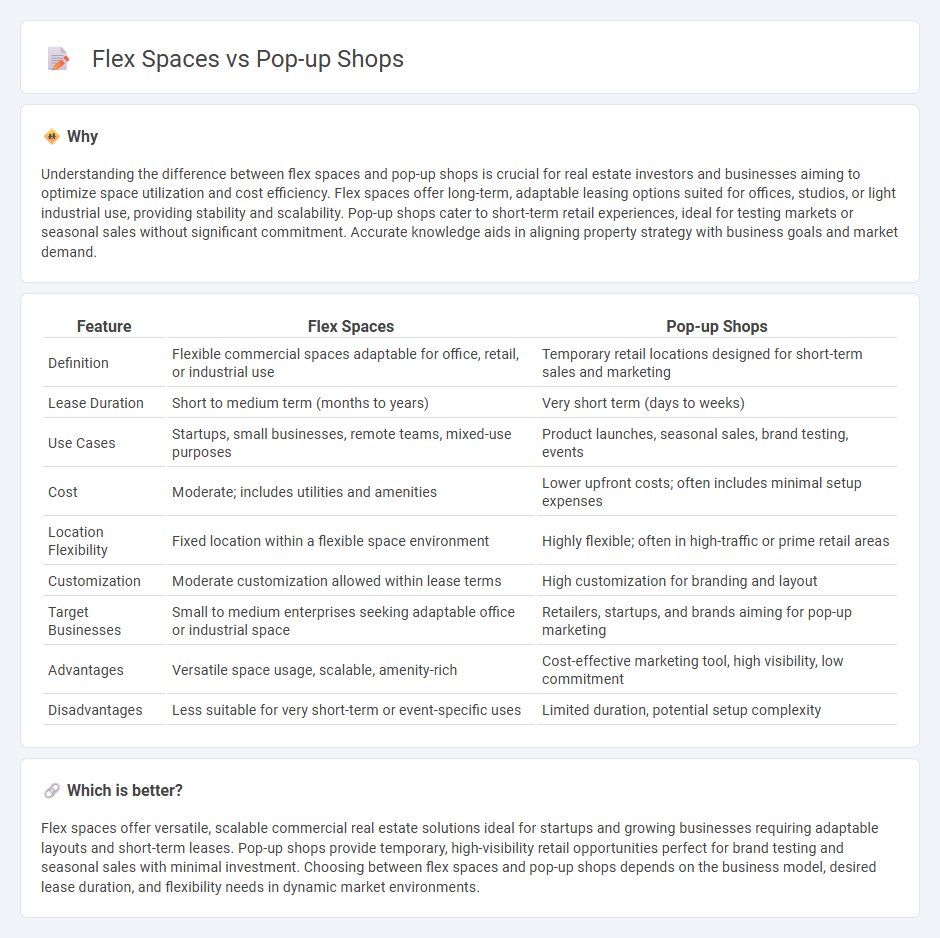
Flex spaces offer adaptable commercial areas designed for a variety of business needs, providing scalable options from co-working desks to private offices. Pop-up shops serve as temporary retail locations that enable brands to test markets, build customer engagement, and create urgency through limited-time experiences. Explore the key differences and benefits of flex spaces versus pop-up shops to find the best solution for your real estate strategy.
Why it is important
Understanding the difference between flex spaces and pop-up shops is crucial for real estate investors and businesses aiming to optimize space utilization and cost efficiency. Flex spaces offer long-term, adaptable leasing options suited for offices, studios, or light industrial use, providing stability and scalability. Pop-up shops cater to short-term retail experiences, ideal for testing markets or seasonal sales without significant commitment. Accurate knowledge aids in aligning property strategy with business goals and market demand.
Comparison Table
| Feature | Flex Spaces | Pop-up Shops |
|---|---|---|
| Definition | Flexible commercial spaces adaptable for office, retail, or industrial use | Temporary retail locations designed for short-term sales and marketing |
| Lease Duration | Short to medium term (months to years) | Very short term (days to weeks) |
| Use Cases | Startups, small businesses, remote teams, mixed-use purposes | Product launches, seasonal sales, brand testing, events |
| Cost | Moderate; includes utilities and amenities | Lower upfront costs; often includes minimal setup expenses |
| Location Flexibility | Fixed location within a flexible space environment | Highly flexible; often in high-traffic or prime retail areas |
| Customization | Moderate customization allowed within lease terms | High customization for branding and layout |
| Target Businesses | Small to medium enterprises seeking adaptable office or industrial space | Retailers, startups, and brands aiming for pop-up marketing |
| Advantages | Versatile space usage, scalable, amenity-rich | Cost-effective marketing tool, high visibility, low commitment |
| Disadvantages | Less suitable for very short-term or event-specific uses | Limited duration, potential setup complexity |
Which is better?
Flex spaces offer versatile, scalable commercial real estate solutions ideal for startups and growing businesses requiring adaptable layouts and short-term leases. Pop-up shops provide temporary, high-visibility retail opportunities perfect for brand testing and seasonal sales with minimal investment. Choosing between flex spaces and pop-up shops depends on the business model, desired lease duration, and flexibility needs in dynamic market environments.
Connection
Flex spaces and pop-up shops share a dynamic relationship by offering adaptable, short-term real estate solutions that cater to emerging business needs and market trends. Flex spaces provide versatile environments suitable for various uses, enabling pop-up shops to quickly establish a physical presence with minimal investment and commitment. This synergy supports rapid market testing and enhances urban commercial vitality through increased consumer engagement and localized retail experiences.
Key Terms
Temporary Lease
Pop-up shops offer short-term retail opportunities that maximize brand visibility and customer engagement without long-term commitments, while flex spaces provide versatile work or retail environments adaptable to various business needs with flexible lease terms. Temporary leases in pop-up shops typically range from a few days to several months, enabling rapid market testing and seasonal sales, whereas flex spaces often support longer, yet still adaptable, lease durations that balance stability and flexibility. Explore the benefits and strategic uses of temporary leases in pop-up shops versus flex spaces to optimize your business location strategy.
Mixed-Use
Pop-up shops offer temporary retail experiences ideal for market testing and brand engagement, while flex spaces provide versatile, multi-functional areas adaptable for retail, office, or event use in mixed-use developments. Mixed-use environments benefit from flex spaces by maximizing occupancy and tenant diversity, promoting a dynamic community atmosphere. Explore how these solutions enhance mixed-use strategies and optimize urban commercial success.
Adaptability
Pop-up shops offer businesses exceptional short-term adaptability, enabling rapid market entry and brand testing with minimal commitment, while flex spaces provide longer-term flexibility, accommodating evolving operational needs through customizable layouts and scalable lease terms. Flex spaces excel in offering scalable environments suited for growing businesses requiring both office and retail components, whereas pop-up shops thrive in creating temporary, high-impact consumer engagements in prime locations. Explore how choosing between pop-up shops and flex spaces can optimize your business's adaptive strategies for changing market demands.
Source and External Links
What is a Pop-up Shop? Benefits, Types, and How to Start - Printify - This guide explains what a pop-up shop is, its benefits, types, and how to start one, highlighting how pop-up shops help businesses create buzz and test new markets without long-term leases.
Pop-up Retail - Wikipedia - This article describes pop-up retail as a temporary sales space used to generate interest in products or services, often used for seasonal items or marketing campaigns.
21 Pop-Up Shop Ideas & Examples (2025) - Shopify - This resource provides 21 successful pop-up shop ideas, including collaborations, exclusive discounts, and interactive elements to enhance the shopping experience.
 dowidth.com
dowidth.com